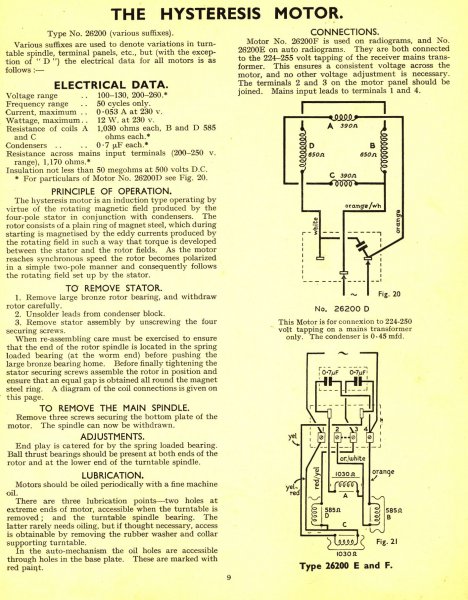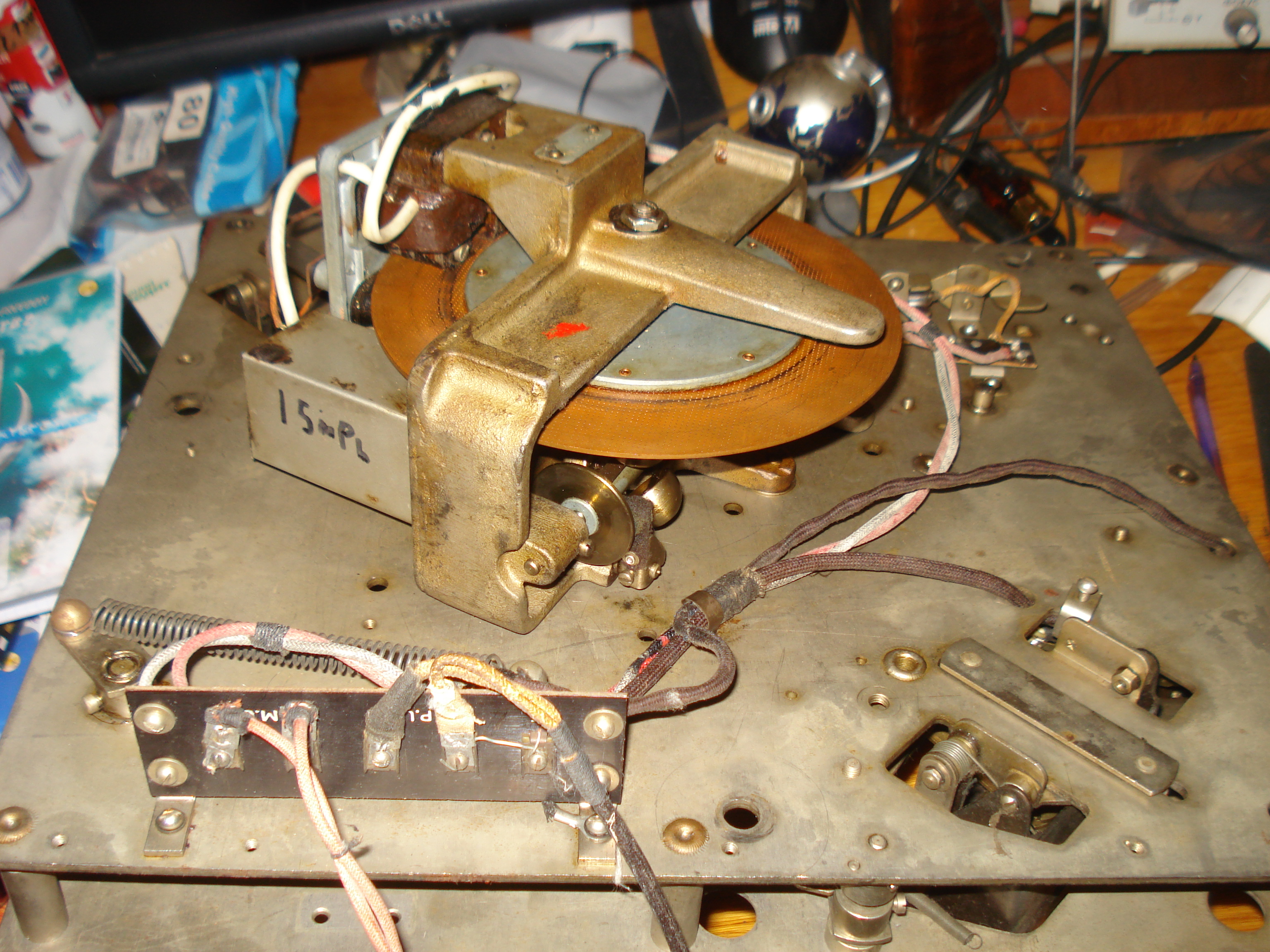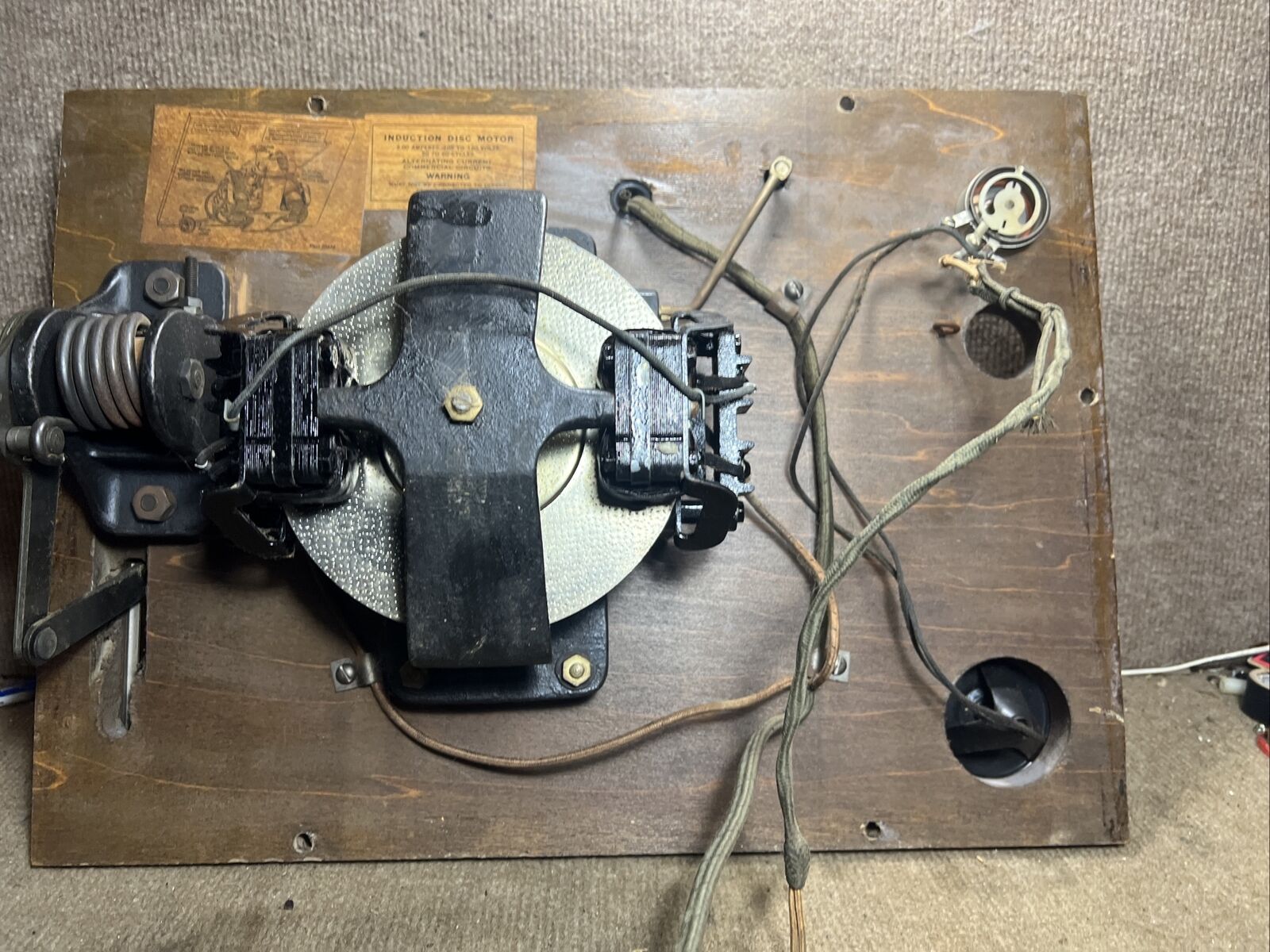The list of my radio & TV collection!
Posts: 15,691
Threads: 551
Joined: Oct 2011
City: Jackson, NJ
Pete,
one correction: Hysteresis motor is synchronous. It does not need starter winding, and has constant toruqe between the start and synch speed when it "catches up" with the stator field.
They are used where very high accuracy of following the field is required.
People who do not drink, do not smoke, do not eat red meat will one day feel really stupid lying there and dying from nothing.
Posts: 572
Threads: 20
Joined: Nov 2014
City: Svalyava Transkarpatia
State, Province, Country: Ukraine
It's amazing. And then what is the function of these windings? This is a diagram of the engine of a Marconi gramophone, but a different model than mine ...

Here, not even three, but four windings and two starting windings are switched on through the phase shift capacitor. Have I misunderstood their function?
PS. And by the way, this engine has a centrifugal mechanical speed regulator. I have seen this only on old pre-war electrogramophones

Old Tube Radio Online Museum / Музей ретро радіо
https://www.youtube.com/user/RadioSvit?d...lymer=true
Sincerely Peter
З повагою Петро
(This post was last modified: 04-02-2024, 07:30 AM by RadioSvit.)
Posts: 15,691
Threads: 551
Joined: Oct 2011
City: Jackson, NJ
A hysteresis motor with 4 poles (2 pairs) will have at 50Hz the speed (synchronous) of 25 rev/sec or 1500 rpm.
You have 4 poles, so it will be that.
>>four windings and two starting windings are switched on through the phase shift capacitor.
Where do you see 6 windings? I see 4 altogether.
As for "not even three, but four windings", with synchronous hyst motors the windings in stator come in pairs. The speed will be your AC frequency divided by the number of pair (with 4 windings you divide by two, hence 25 rps or 1500 rpm).
True synch motor does not need speed regulator as it cannot possibly exceed the synch speed, it can only achieve it and lock to it.
The centrifugal regulator in asynch motors is not the speed regulator but the "start capacitor switch". It does not regulat speed.
If you do have starting cap and the centrifugal switch, then maybe it is not a hysteresis motor after all?
The synch motor simply does not need anythingm, winding or capacitor, to start, as it develops torque right from the get-go, amd the torque does not change with the speed as it catches up with the field rotation.
People who do not drink, do not smoke, do not eat red meat will one day feel really stupid lying there and dying from nothing.
Posts: 572
Threads: 20
Joined: Nov 2014
City: Svalyava Transkarpatia
State, Province, Country: Ukraine
Quote: >>four windings and two starting windings are switched on through the phase shift capacitor.
Michael, this is an example of an incorrect Google translation, I was talking about four windings, two of which are starting.
Майкл, это пример некорректного гугло перевода, я говорил о четырех обмотках, две из которых являются пусковыми.
Quote: True synch motor does not need speed regulator as it cannot possibly exceed the synch speed, it can only achieve it and lock to it.
The centrifugal regulator in asynch motors is not the speed regulator but the "start capacitor switch". It does not regulat speed.
If you do have starting cap and the centrifugal switch, then maybe it is not a hysteresis motor after all?
The synch motor simply does not need anythingm, winding or capacitor, to start, as it develops torque right from the get-go, amd the torque does not change with the speed as it catches up with the field rotation.
Michael, your arguments are very logical, but you completely confused me with them.  The fact that this motor is hysteresis was told to me by the owners of similar electrogramophones on the English forum UK Vintage Radio Repair and Restoration. And what is very interesting, there is a mechanical regulator of the disk rotation speed. Did I understand correctly that in this case it is definitely not a synchronous motor, and maybe not even a hysteretic one, but most likely an asynchronous one?
But there is a disc like in hysteresis motors. This is a mystery. 
Old Tube Radio Online Museum / Музей ретро радіо
https://www.youtube.com/user/RadioSvit?d...lymer=true
Sincerely Peter
З повагою Петро
Posts: 15,691
Threads: 551
Joined: Oct 2011
City: Jackson, NJ
Got it, this darn Google.
Well, you could do a search on the motor you have, maybe even photograph and feed it to Google.
When you say "centrifugal regulator", what kind? Switch? Or the old style like those balls on steam engine that change the gear ratio, purely mechanical?
Synch, especially hysteresis, motor has no use for it, as any mechanical speed regulation would fight the rotating EM field. I am not sure how it would work.
The synch motors are used in Variable Speed drives where their speed is regulated by the field frequency. Regulating it mechanically is, well, kinda wrong.
If the motor runs a gearbox, where the regulator changes the gear ratio, then yes, that is quite possible.
People who do not drink, do not smoke, do not eat red meat will one day feel really stupid lying there and dying from nothing.
Posts: 572
Threads: 20
Joined: Nov 2014
City: Svalyava Transkarpatia
State, Province, Country: Ukraine
Old Tube Radio Online Museum / Музей ретро радіо
https://www.youtube.com/user/RadioSvit?d...lymer=true
Sincerely Peter
З повагою Петро
(This post was last modified: 04-04-2024, 04:36 AM by RadioSvit.)
Posts: 15,691
Threads: 551
Joined: Oct 2011
City: Jackson, NJ
SO, was I right when I theorized that it was 2-ball regulator moving gears to change the gear ratio?
I cxannot quite tell it fom the photos, but sure looks like it.
Yes that is possible.
What is the rotor made of? Copper?
If it is, what yoou have is likely the induction disc motor. Very much the same type that is used in house electric meters (or used to be used).
It is based on rotating magnetic field and eddy currents in the disc.
A similar one:
https://www.ebay.ca/itm/134565999569
https://www.ebay.com/itm/364371922804

The same principle also exists in disc relays.
Basically the pole and the disc produce zero torque, but then you could divide the pole in half, and make a shorted turn around one half, thus making the torque non-zero.
https://www.nprcet.org/site/download?fil...otesu2.pdf
This is the article; find the "Induction disc relay" and "Pole shading method of producing torque"
People who do not drink, do not smoke, do not eat red meat will one day feel really stupid lying there and dying from nothing.
(This post was last modified: 04-04-2024, 09:21 PM by morzh.)
Posts: 572
Threads: 20
Joined: Nov 2014
City: Svalyava Transkarpatia
State, Province, Country: Ukraine
Today, I repaired an old Soviet Molotov gramophone of 1950, which is a copy of the English HMV 102. Before that, it worked very poorly, because the speed was unstable due to the poor operation of the centrifugal speed regulator, and the tonearm support was jammed. After replacing the bearing and lubricating the speed controller, everything worked perfectly.
[Video: https://www.youtube.com/watch?v=u5gY8sWT27Y&t=51s]
Old Tube Radio Online Museum / Музей ретро радіо
https://www.youtube.com/user/RadioSvit?d...lymer=true
Sincerely Peter
З повагою Петро
Posts: 15,691
Threads: 551
Joined: Oct 2011
City: Jackson, NJ
Brings back memories. Even when I was a child, this was already quite outdated.
I saw electrogrammophones, like that that was in our house, which would plug in the back of our Melodiya radio, and even that was on its way out.
However in some rural places those were still in use. Plus they were portable and did not need a power source.
The one time I saw it in action was when I was in the 3rd grade, and our teacher brought this exact one in class to play the song we were supposed to learn during the "singing" lesson.
I even remember the song:"Zhuravel'" (a Crane).
The words are funny:
Povadilsya Zhuravel'
Da po nashu konopel'.
(A crane got into a habit of coming to eat our cannabis plants).
Then in the song the owner of the cannabis promises to clip the crane's wings, so he stops flying in and eat his crop.

People who do not drink, do not smoke, do not eat red meat will one day feel really stupid lying there and dying from nothing.
Posts: 572
Threads: 20
Joined: Nov 2014
City: Svalyava Transkarpatia
State, Province, Country: Ukraine
Michael, you will laugh, but such gramophones were manufactured in the USSR until 1962 ...  And if you remember that this is a copy of the English HMV 102 from 1922, then you can consider that this model is 102 years old, and the concept of portable folding gramophones is even older - more than 110 years
Old Tube Radio Online Museum / Музей ретро радіо
https://www.youtube.com/user/RadioSvit?d...lymer=true
Sincerely Peter
З повагою Петро
Posts: 15,691
Threads: 551
Joined: Oct 2011
City: Jackson, NJ
Many things were manufactured in the USSR that were all but forgotten in the West, especially in the USA as the hotbed of innovation.
From that angle one could say that it was a living museum of old technology.
Sort of like peopl travel to Cuba to get rides in classic cars as that part of technology has been frozen in time, and the cars are kept in running shape out of necessity and not for other reason, so the 50-s classics still are roaming the streets of Havana, offering tourists (American amongst them) a ride for a small fee.
People who do not drink, do not smoke, do not eat red meat will one day feel really stupid lying there and dying from nothing.
Posts: 4,682
Threads: 51
Joined: Sep 2008
City: Sandwick, BC, CA
Mike; Peter;
I think that the governor on the phonograph/gramophone motor in the HMV actuates a brake rather then changing the gear radio, as the balls fly out it pulls a disk against a pad of some sort like felt or cork, and it slows the speed slightly. Was the phonograph made by Gerrard, it looks like a Gerrard tone arm?
With regards to portable record players with a spring motor, I can remember hearing that they made them in India right into the 1970s, if not later, they too may have been HMV copies, as a lot of products made in India were licensed copies of older British ones.
Regards
Arran
Posts: 4,682
Threads: 51
Joined: Sep 2008
City: Sandwick, BC, CA
Mike, Peter;
Another thing I was wondering about, why did they name so many manufacturing companies/factories after Molotov? He was the foreign minister under Stalin, what did he have to do with manufacturing cars, radios, or gramophones?
Regards
Arran
(This post was last modified: 04-21-2024, 05:54 PM by Arran.)
Posts: 15,691
Threads: 551
Joined: Oct 2011
City: Jackson, NJ
Arran
Molotov was a BIG PARTY OFFICIAL.
That was enough.
As for the governor, I cannot say it is so, but with felt/cork being not reliable, plus you cannot keep the rubbing action non-stop (wear, heat, irregularity), I just wonder if, if it is not gear ratio, then could it be something like the speed regfulation in Thorens, through eddy currents and magnet? It works great. Just move the magnet closwer to the disk, and voila.
People who do not drink, do not smoke, do not eat red meat will one day feel really stupid lying there and dying from nothing.
Posts: 4,682
Threads: 51
Joined: Sep 2008
City: Sandwick, BC, CA
Mike;
You may be correct, now that I look again there appears to be a lever going above the deck and under the platter somewhere, what it activates is not shown, it could be a clutch, or a switch.
Regards
Arran
Users browsing this thread: 8 Guest(s)
|
|
Recent Posts
|
|
Jackson 715 not working
|
| Mrfixr55, its working now. I cleaned the switches and sockets with spray cleaner. Thanks for helping on this one.daveone23 — 06:26 PM |
|
Jackson 715 not working
|
| Now that you posted the schematic, I don't know why that Sprague electrolytic cap is across the meter, as it is not indi...MrFixr55 — 05:51 PM |
|
HiFi (Chifi) tube amp build - but my own design.
|
| What may be lacking in the PP Tube amps may be the 2nd harmonics, which some, especially RCA back in the day called &quo...MrFixr55 — 05:32 PM |
|
Jackson 715 not working
|
| Usually in an emission tester, the tube under test is measured as if it were a diode. So, some testers connect all the g...RodB — 04:17 PM |
|
Restoring Philco 37-604C
|
| Yep. F5 is green, D5 is Red.
Red is Bad.
Green is Clean.morzh — 01:30 PM |
|
Jackson 715 not working
|
| I did start to do that but I stalled out because I could not figure out how the grid and plate get voltage. In this diag...daveone23 — 11:52 AM |
|
Restoring Philco 37-604C
|
| (Insert Homer Simpson "DOPF" Here.)
When all fails, look at the can. Took the Ron Ramirez advice, red Caig D...MrFixr55 — 09:23 AM |
|
Philco 91 Speaker Replacement
|
| From your text I am not sure if you intend to use the existing speaker with a resistor instead of the field coil.
It wo...morzh — 08:44 AM |
|
Philco 91 Speaker Replacement
|
| My field coil is bad. I am still hoping to find an original, but if I can't I will go with a fitting Philco speaker, 125...dconant — 08:34 AM |
|
Philco 91 Speaker Replacement
|
| As Rod said, it is OK to use a fitting speaker, and then look for an original one.
If you buy a Hammond 125 output tr...morzh — 08:15 AM |
|
Who's Online
|
There are currently 4053 online users. [Complete List]
» 1 Member(s) | 4052 Guest(s)
|
|
|

|
 
|



![[-] [-]](https://philcoradio.com/phorum/images/bootbb/collapse.png)


